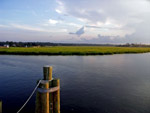
Tidal Marshes Protect Aquatic Ecosystems and Store Carbon
A study of nitrogen and phosphorus retention and carbon sequestration along the Georgia coast suggest that tidal marsh soils protect aquatic ecosystems from eutrophication, caused by the accumulation of nutrients that disrupt ecosystems and reduce oxygen and biological diversity.
Tidal marshes consist of salt, brackish and tidal freshwater marshes that exist along a gradient of decreasing salinity from the ocean inland. Scientists from Indiana University’s School of Public and Environmental Affairs measured carbon sequestration and nutrient accumulation in soils of salt, brackish, and tidal fresh marsh soils of three rivers, Ogeechee, Altamaha and Satilla, of the Georgia coast.
Results from the study were reported in the May-June 2010 issue of the Soil Science Society of America Journal, published by the Soil Science Society of America (SSSA). The study was funded by the U.S. Environmental Protection Agency’s Science to Achieve Results (STAR) program and the National Science Foundation’s Georgia Coastal Ecosystems Long Term Ecological Research Program.
Overall, the study concluded that tidal marshes of the three rivers remove or store the equivalent of 13 to 32 percent of the nitrogen entering the estuaries from their respective watersheds, while collectively sequestering more than 39 metric tons of carbon per year. Improving the management, protection, and restoration of the less abundant, but higher functioning tidal freshwater and brackish marshes is key for optimizing nitrogen and phosphorus retention and reducing coastal eutrophication.
“Current management practices focus on controlling nutrient releases into rivers and streams,” said Mark Loomis, Ph.D., who helped spearhead the study. “However, development in these watersheds and wetlands is increasing, and as a result, eutrophication of coastal waters will likely get worse in the future. Tidal marshes, in addition to their water quality benefits, provide critical habitat for recreational and commercial fisheries. So we need to protect and restore these habitats before they are lost.”
Human activities in coastal watersheds contribute elevated levels of nitrogen and phosphorus to rivers, streams, and estuaries that contribute to eutrophication of aquatic ecosystems. Tidal marshes intercept and filter nutrients in surface waters, storing these nutrients in soils, thereby improving water quality in estuaries.
The study also found that different kinds of tidal marshes vary in their ability to sequester carbon and retain nutrients. Tidal fresh and brackish marshes are more effective than an equal area of salt marsh, sequestering two to three times more carbon and nitrogen, mostly through greater soil accretion and organic matter content. Tidal fresh and brackish marshes account for only 41 percent of marsh area yet sequester 66 percent of the carbon and 69 percent of the nitrogen stored by all tidal wetlands in the region.
Chris Craft, Ph.D., and his research group also are investigating the effects of fertilizers on tidal fresh marshes, as well as how climate change-driven sea-level rise will affect the ability of tidal wetlands to sequester carbon and filter nutrients in the future. Further research is needed to document the benefits of other coastal wetlands, such as alluvial, floodplain and mangrove forests, to sequester carbon, retain nutrients and reduce the impacts of coastal water eutrophication.
SSSA is a progressive, international scientific society that fosters the transfer of knowledge and practices to sustain global soils. Based in Madison, Wis., and founded in 1936, the society is the professional home for more than 6,000 members dedicated to advancing the field of soil science.